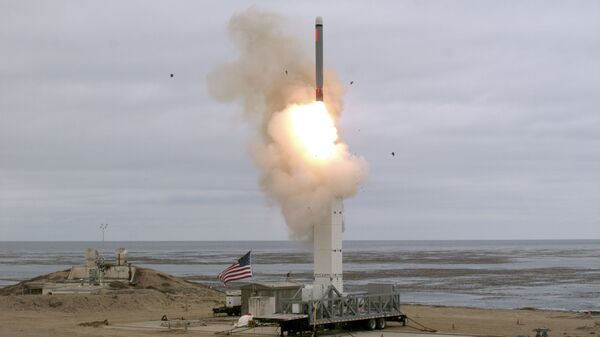Brig. Gen. John Rafferty, director of the US Army’s Long-Range Precision Fires (LRPF) Cross-Functional Team, said recently that an intermediate-range missile capable of hitting targets between 500 and 1,500 kilometers (310 and 930 miles) away would be a serious asset in a future conflict with Russia or China.
For perspective, 930 miles is the distance from Moscow to the German-Polish border, or from Okinawa to Dalian.
“What a dilemma that would create for our adversary,” Rafferty said on September 29 at the 2020 Army Fires Conference. “How we would change the calculus in a second, if we could deliver this kind of capability out there.”
While the LRPF chief gave no indication the missile was actually in development, the Pentagon has pursued numerous other weapons systems with similar ranges over the last two years, since Washington announced it was withdrawing from the 1987 INF Treaty. One weapon, a Tomahawk cruise missile with a 1,000-mile range modified to be fired from a ground-based location, was test-fired barely two weeks after the treaty formally lapsed in August 2019.

The United States and then-Soviet Union signed the treaty in 1987 after the US stationed Pershing II ballistic missiles in Europe. The missiles had the capacity to close the roughly 1,000-mile gap between West Germany and Moscow in between six and eight minutes, greatly increasing the risk of nuclear war by giving inadequate time for Soviet forces to verify an attack was underway. The treaty banned the two powers from building or using land-based missiles armed with both conventional and nuclear warheads with ranges of between 500 and 1,500 kilometers.
Rafferty said developing LRPFs is the Army top modernization priority, because it “enables access at the strategic level and it enables combined arms maneuver at the tactical level.”
Other similar weapons in the works are the Precision Strike Missile (PrSM), an updated projectile for HIMARS rocket artillery with a maximum range of 500 kilometers, and an ultra-long-range artillery piece that can fling shells some 70 kilometers away that has been dubbed the Extended Range Cannon Artillery (ERCA).
The PrSM has already been through three successful tests, but Rafferty said the weapon’s maximum range has not yet been truly tested. “We’ll go to Vandenberg Air Force Base and we’ll test it out into the [Pacific] ocean and see how far it will go,” he told the conference. The ERCA could begin prototype testing with an artillery battalion by 2023, he also noted.
While LRPFs have been the Army’s top priority for several years, the Pentagon formally remained within the confines of the INF Treaty, even though Washington was already seeking to dismantle the agreement. Sputnik reported in March 2019 - five months before the treaty lapsed - that the Pentagon had placed funding for several INF Treaty-violating missile systems in its fiscal year 2020 budget, and by May of that year had penned more than $1 billion in new contracts for INF Treaty-violating missiles.
However, even before that, Russia had called attention to the dangers of the Aegis Ashore system, a missile guidance system taken from a warship and placed at a land base in Deveselu, Romania, noting it could be used to launch offensive weapons. Washington claimed the system was only configured for intercepting incoming missiles and brushed off Moscow’s fears.
According to US Defense Secretary Mark Esper, the US was forced to exit the INF Treaty in order to compete with Russia, which he said has violated the treaty for years with its Iskander short-range ballistic missile system. Moscow has long denied the system has a range banned by the treaty and has accused Washington of using Iskander as an excuse to torpedo the pact.

